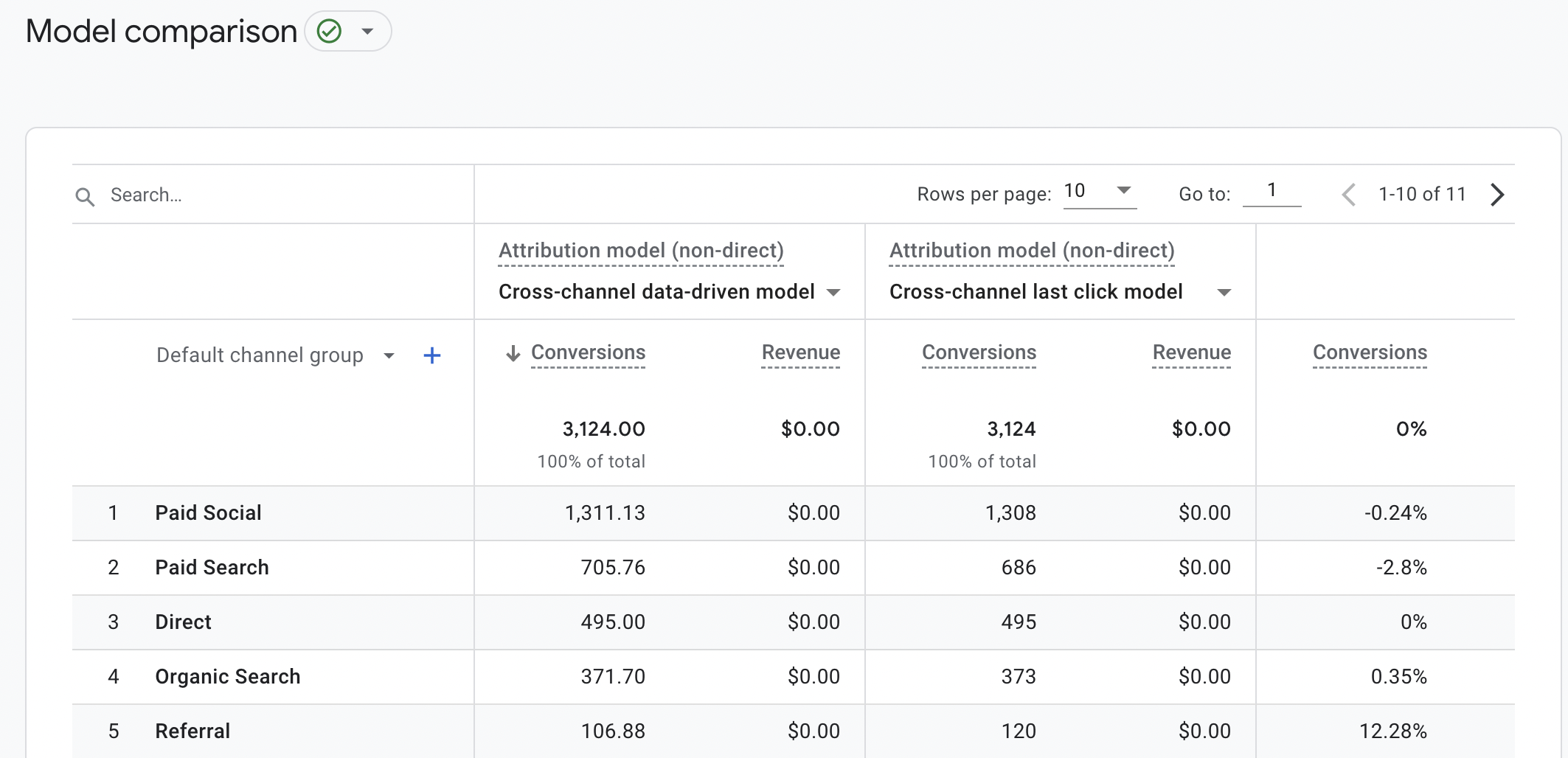-
 Written by Sean Dougherty
Written by Sean DoughertySenior Brand Creative at Funnel, Sean has more than 15 years of experience working in branding and advertising (both agency and client side). He's also a professional voice actor.
The typical customer journey involves multiple interactions across multiple channels. But how can you determine which of these interactions actually drive your customers to make a purchase?
For many marketers, the answer is to apply multi-touch attribution. However, like other types of marketing attribution, it isn't always reliable.
So should you use it or not? And how does multi-touch attribution work in the context of Google Analytics 4 (GA4)? We'll answer all of these questions below.
What is multi-touch attribution?
Multi-touch attribution measures the impact of marketing channels on your campaigns and how they influence conversions. Using this model, you can assign a value to various touchpoints during a customer's journey, which helps determine how specific channels play a role in the conversion process.

A Google search for SAYE shoes gives our customer plenty of sponsored results.
Let's say a customer searches for shoes on Google and clicks on a search engine result that brings them to your online store. The customer doesn't make a purchase just yet, though. A couple of weeks later, the customer sees a post about your shoes on Instagram, clicks on it, ends up on your online store again, and finally makes a purchase.

With retargeting, the customer sees an advert that takes them to the online store again
Along the way, the customer might have also seen a display ad on a blog, a post on TikTok and maybe a collaboration post with an influencers. The journey from first sight to final purchase is a-linear and notoriously difficult to track. And what that means for marketers is: it's hard to tell which parts of your marketing campaign are having the biggest effects. Was it the display ad that convinced them? Maybe they saw that after seeing the influencer collab and had already made up their minds to purchase?
.png?width=780&height=299&name=PATH%20TO%20(3).png)
With the multi-touch attribution model, you can assign each touchpoint a different value to determine how much each channel (Google, Instagram and TikTok) contributed to the conversion event (purchasing the shoes). These values are normally applied as a percentage. So, you might give Google 40% credit, TikTok 10%, display 10% and Instagram 40% credit.
Proponents of multi-touch attribution say that when you assign values to different touchpoints, you learn which ones convert the most customers. You can then use this information to fine-tune your marketing strategies.
The most important multi-touch attribution models
So how does multi-touch attribution software help you come up with these values? It all depends on the model you use. Some models let you assign credit to touchpoints based on pre-determined rules defined by your marketing team, while others use statistical methods and machine learning.
1. Linear attribution model
This model gives equal credit to every touchpoint in the buyer's journey, because it assumes all touchpoints have the same value. Using the example above, this would give Google, Instagram, TikTok and display an equal 25% credit each. While this model is great for learning how different touchpoints work together to influence conversions, it doesn't show the impact of each individual touchpoint.
.png?width=780&height=326&name=linear%20attributino%20(2).png)
A linear attribution model.
2. Time decay attribution model
This model gives more credit to touchpoints toward the end of the customer journey, usually, those that occur just before a buyer makes a purchase. The assumption is that these touchpoints impact a customer's purchasing behavior more. In our example, Instagram would receive more credit than the touchpoints that came before it.
.png?width=1102&height=460&name=time%20decay%20(1).png)
3. Data-driven models
Data-driven multi-touch marketing attribution models use artificial intelligence (AI) to decide which touchpoints receive the most credit for a conversion event. That can make attributing specific touchpoints to conversions easier, because you don't have to develop attribution rules yourself (machine learning does it for you). These models identify the touchpoints with the greatest influence based on complex algorithms, but we'll explain this more later.
.png?width=1102&height=460&name=custom%20(1).png)
AI can help marketers understand the most powerful touchpoints with greater accuracy.
Research shows that only 22% of marketers believe they're using the right attribution model. That's pretty low, and may contribute to the general lack of confidence marketers have in their ability to work with data. Adding powerful and mysterious machine learning models into the mix may confuse things further. Plus, those algorithms need enormous amounts of data to generate meaningful insights, and implementing data-driven models can be extremely expensive.
Long story short: data-driven models, while powerful, require a certain level of data maturity to implement them properly.
That's just the tip of the iceberg. There are a wide range of multi-attribution models, including U-shaped and W-shaped attribution. The former gives more credit to the first and last touchpoints in the customer journey, while the latter considers the touchpoints in the middle.
Lots to consider.
One-touch attribution vs. multi-touch marketing attribution
Whatever model you choose, know that multi-touch attribution is very different from one-touch attribution (or single-touch attribution). While multi-touch gives credit to multiple touchpoints in the buyer's journey, one-touch gives credit to just one. In our example, Twitter would get 100% of the credit because the touchpoint led directly to conversion — the customer purchasing the shoes.
As with multi-touch attribution, there are different one-touch attribution models:
1. First-touch attribution model
First-touch attribution gives conversion credit to the first touchpoint in the customer journey. In our example, that would be Google. We know what you're thinking: "Sure, Google was the first touchpoint, but was it really the one that led to the conversion?"
That's the problem with the one-touch model in general. It doesn't consider all the other interactions a customer has with your business. Alas, first-touch assumes the first touchpoint is the most important one.
.png?width=1102&height=460&name=first%20(1).png)
First-touch attribution gives all the credit to the first touchpoint.
2. Last-touch attribution model
Last-touch attribution gives credit to — you guessed it — the last touchpoint in the customer journey. That's Twitter, in our example. Again, that poses problems by ignoring other touchpoints before the last touch.
Things can get a little more complicated here, though. Last-touch attribution is actually similar to "last non-direct attribution," which is a multi-touch attribution model that gives credit to the final touchpoint (as long as it's not a direct visit). For example, a customer directly types your URL into their browser and then purchases a product.
.png?width=1102&height=460&name=last%20(1).png)
Last-touch attribution gives all the credit to the final touchpoint before purchase.
3. Last-click attribution model
Last-click is similar to last-touch, but it gives full credit to the last link a customer clicked on before making a purchase. Say a customer clicked on a Google ad and landed on your online store. Then, they saw a pop-up ad promoting a discount for new shoes. Despite the ad being the last interaction before a purchase, this model would assign credit to the search engine result — the final click.
Which model to use?
There are no clear answers. The model you choose depends entirely on your business model and, to be honest, which touchpoints you value the most. Marketers who think the last touchpoint is the most important will use last-touch or non-direct attribution.
As we’ve explained before, there are downsides to all the attribution models we've listed above and problems with marketing attribution in general. Data-driven models might look like they're generating amazing conversion insights, but they don't reveal any information about how they come up with their calculations. So, it's kind of like a black box. Meanwhile, models like last-touch attribution give too much credit to performance marketing channels like Google Ads.
There are other issues, too. While multi-touch attribution is better than one-touch because it considers all the touchpoints during the buyer's journey, no marketing attribution can ever be 100% objective. That's due to:
- Some industries have very long buyer journeys, with prospects using various devices to interact with your ads and website at different times. Tracking all buyer touchpoints during these journeys can be a mammoth task.
- Some web browsers, such as Firefox, block almost all cookies, making it difficult to track a prospect's behavior during their journey.
- In B2B, several people might be involved in purchasing a product or service, but only one will make the eventual transaction. That makes it nearly impossible to fully understand which marketing channel contributed to a lead or sale.
Recommended reading: The digital marketing attribution problem
Multi-touch attribution in Google Analytics 4
Data-driven attribution can be easier than other methods, because it frees up resources for your team, despite being expensive and requiring lots of data. These models come up with all the pre-determined rules for attribution for you. GA4 has its own data-driven attribution model and claims to "provide deeper insights and more actionability than ever before."
GA4's algorithms distribute conversion credit based on data generated for each conversion event from your Google Ads account. These algorithms calculate the actual contribution of each click interaction to determine both converting and non-converting paths, helping you learn which touchpoints influence conversions the most.
Here's what Google says:
The model incorporates factors such as time from conversion, device type, number of ad interactions, the order of ad exposure, and the type of creative assets. Using a counterfactual approach, the model contrasts what happened with what could have occurred to determine which touchpoints are most likely to drive conversions. The model attributes conversion credit to these touchpoints based on this likelihood.
Comparing attribution models in GA4
You can compare how different attribution models result in different conversion events in GA4 by viewing the Model Comparison report. Find this report in the Advertising tab under Attribution. It looks like this:

In the above example, we selected the data-driven attribution and last-click models. In the last column, you can see the percentage difference. Referral, for example, has 12.28% more credit in the last-click model compared to the data-driven model.
GA4 doesn't always reveal the full picture. YouTube, for example, may perform better in a first-click model than a last-click model. So it's better to judge YouTube as a see-channel than a conversion channel.
Update April 2023:
Google announced that they will be sunsetting first-click, linear, time-decay and position-based attribution models. Read more about it on the GA support website:
https://support.google.com/analytics/answer/9164320?hl=en#040623
Should you use Google Analytics for multi touch attribution?
While many marketers use GA for Multi Touch Attribution, it may not be the best solution. Even Google's Data Driven model, which is their most sophisticated one, takes into account only clicks on ads, not impressions. So, while GA is great for simple web analytics, it is - for most companies - not a great tool for marketing measurement or marketing attribution. Luckily, many vendors have developed more robust multi touch attribution models that are available now.
Attribution vs. contribution
While GA4 might make multi-touch attribution (and one-touch attribution) easier for some marketers, it doesn't address the problems with digital marketing attribution in general. So what's the alternative?
Most modern marketers want to see the touchpoints and channels driving conversions. Finding the right attribution model and figuring out algorithms slows down that goal.
So why don't we shift our focus from attribution to contribution? Instead of using pre-determined attribution rules and complex models, why don't we work out what influences conversions?
Contribution helps you understand how your entire marketing strategy impacts conversion events. It's about looking at the bigger picture — how all your channels work together to boost conversions. There are different ways to do this:
Recommended reading: Why modern marketers shouldn’t focus on ROAS alone
1. Testing
A/B testing helps you determine which campaign variation impacts conversions most. But for more explosive results, geo-testing uses geographical regions (or geos) to test and track different responses to your marketing. For example, you can identify ROI from social media campaigns in different parts of the world.
2. Incrementality
Incrementality is growth you can attribute to marketing efforts, showing you the real effect of your campaigns. You can determine the likelihood of a conversion event and the percentage of conversions generated from specific campaign elements.
3. Data analysis
Data analysis lets you identify patterns and trends in your marketing data to learn more about conversions and how people interact with your campaigns. Regression analysis is a more advanced type of analysis that measures the impact of campaign elements on conversions.
4. Marketing Mix Modeling (MMM)
We’ve mentioned the benefits of MMM if you have an advanced data team. This modeling helps you learn which channels contribute the most to conversions while considering historical data, marketing data sources, and other external factors.
See what Funnel's VP of Measurement, János Moldvay, has to say about multi-touch attribution.
Final Word
Multi-touch attribution is a type of marketing attribution that looks great on paper. But if you dig a little deeper, you'll find it's not all it's cracked up to be. Sure, multi-touch attribution can guide you when learning which touchpoints impact conversion events most. However, each of the many multi-touch attribution models give credit to completely different marketing touchpoints, which makes it difficult to know what's really driving conversions.
For example, time-decay gives credit to touchpoints toward the end of the customer journey, while linear attribution assumes all touchpoints have the same value. Which model is right? Data-driven models, like those used by GA4, also raise problems about the effectiveness of attribution. We believe that understanding how your marketing channels work together through contribution is a better way to measure conversions.
-
 Written by Sean Dougherty
Written by Sean DoughertySenior Brand Creative at Funnel, Sean has more than 15 years of experience working in branding and advertising (both agency and client side). He's also a professional voice actor.
